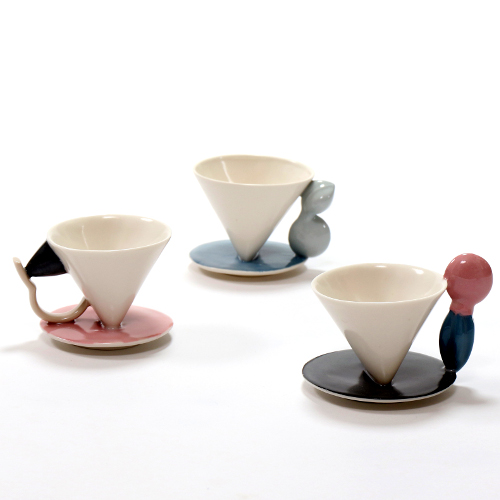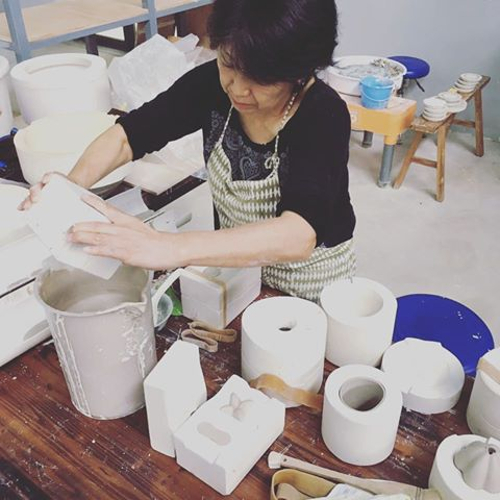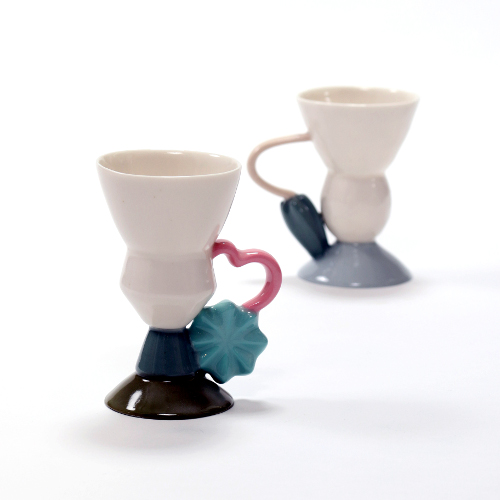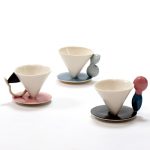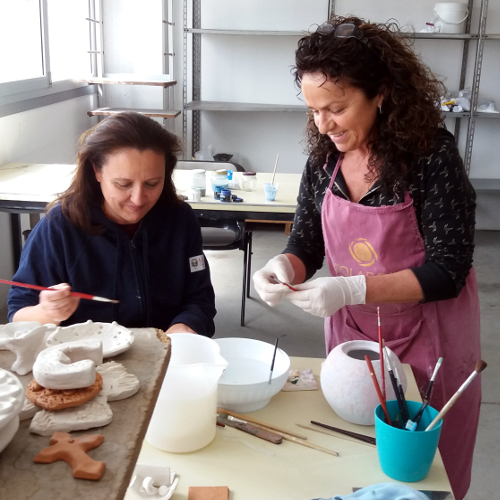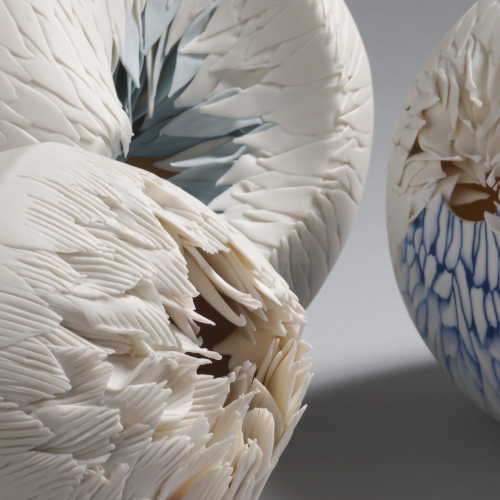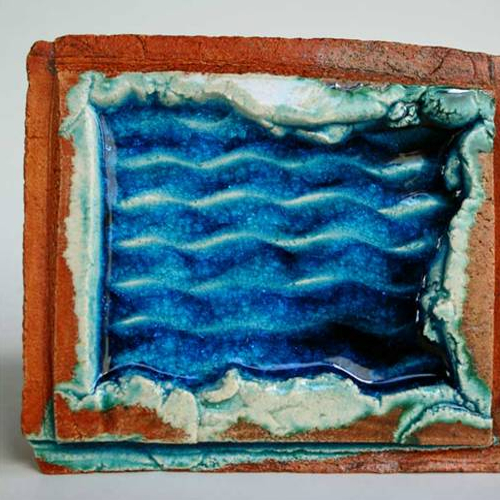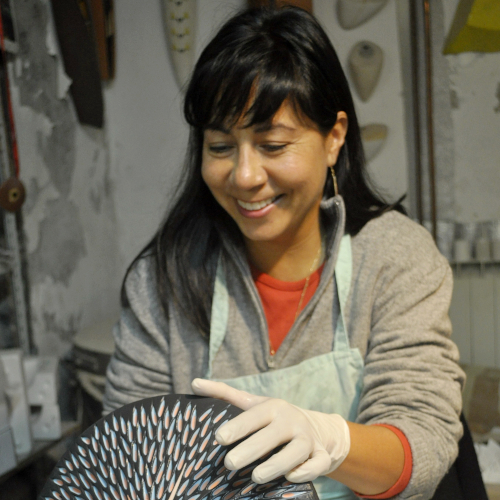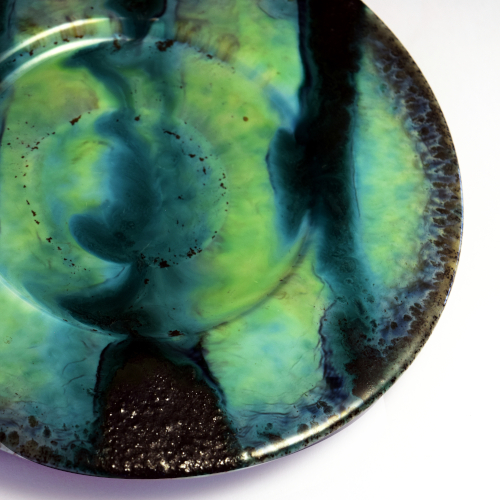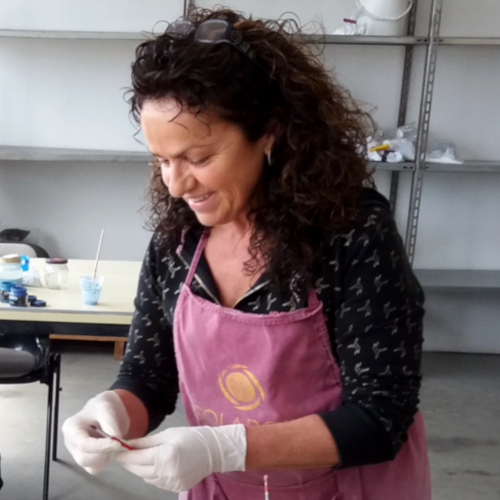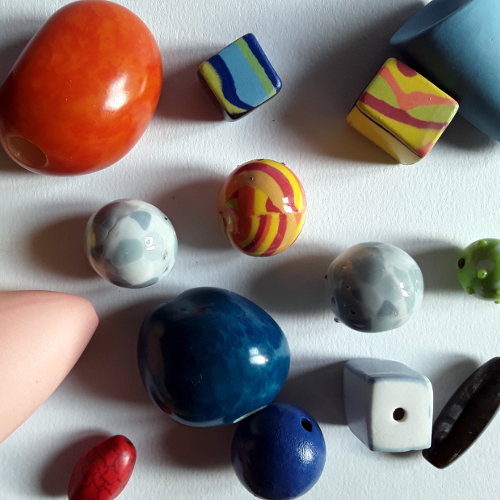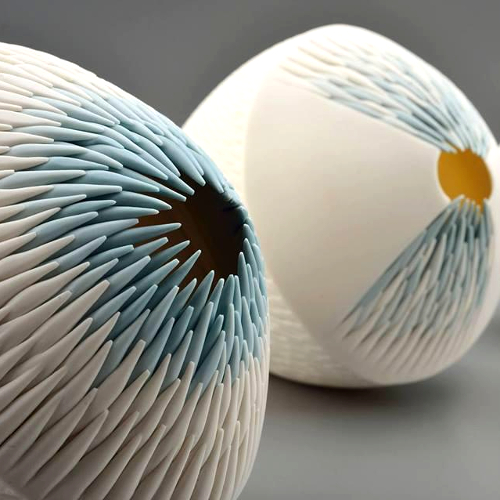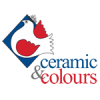Extraordinary japanese constructions with Kazuko Uga
10 and 11 October 2018
A complex and fascinating technique focused on the personal artistic work of Kazuko Uga. The construction of the liquid porcelain will allow us to develop contemporary projects of great beauty, refinement and lightness. Course of construction of objects with the use of white and pigmented liquid porcelain. Course of construction of objects with the use of slip porcelain and treatment of surfaces in the Japanese style. Preparation of porcelain, recipes. Drying, firing, glazing, corrections of cracks and deformations.
The artist will be on show in Faenza from the 9th to the 21st of October as part of the “Japanese
October” Festival.
PROGRAM:
Fully practical lessons with a theoretical chapter dedicated to the preparation of slip withe and coloured porcelain.
First day:
Preparation of liquid porcelain, precautions.
Preparation of liquid coloured porcelain, recipes and percentages.
Methods of slip casting porcelain.
Construction with the small parts, finishing, drying.
Firing, kiln management for high temperature.
Second day:
Finishing and cleaning pieces, tricks and corrections.
Evaluation of results.
Design of new pieces for both sculpture and use.
Video-projection of the artist’s works.
The 14-hours workshop lasts from 9.00 to 17.00 on Wednesday and from 9.00 to 16.00 on Thursday.
Teacher: Kazuko Uga
Translator and assistant: Martha Pachon
Languages: English, Italian, French, Spanish, Japanese
Download the application form in pdf
Download the full program in pdf
Related products
In search of movement with Paula Bastiaansen
21, 22 and 23 September 2018
A workshop in search of movement, rhythm, the absence of gravity, fragility and transparency. Paula Bastiaansen will show you the use of porcelain so light that this body will become almost immaterial.
PROGRAM: - Conference and presentation of slides. - Demonstration of the working method. - Designing an object starting from a drawing. - Preparation and coloring of porcelain. - Preparation of extremely thin porcelain layers. - Cutting of the shapes and construction starting from the drawing. - Use of inlay and stoneware support in construction. - Drying and firing. The 20-hour workshop lasts from 9.00 to 17.00 on Friday and Saturday and from 9.00 to 16.00 on Sunday.Teacher: Paula Bastiaansen Translator and Assistant: Martha Pachon Languages: English, Italian, French, Spanish, Dutch
Dowload the Paula Bastiaansen CV
Download the application form in pdf Download the full program in pdf
Prehistoric firings
18 and 19 November 2017
Per chi ama i modi naturali e vede nella ceramica le varietà espressive che questi possono dare. Porterete tre forme essiccate (non cotte) di misura massima singola cm 20 (altezza) x 10 x 10 a spessore max mm7 realizzate in argille bianche da Raku. Le superfici delle forme potranno essere levigate a pressione ma non ingobbiate. Faremo esperienza di applicazione di argille su argille, di smalti in monocottura e di fiammature con cottura a legna che con la sua casualità ci mostrerà giochi infiniti di trasparenze, neri e lustri.
Programma: applicazione sulle vostre forme secche di ingobbi del genere Terra Sigillata, sali metallici, vernici e smalti – cottura notturna a biscotto – allestimento del fuoco e inserimento delle forme – cottura a legna – estrazione delle forme a mezza e fine cottura – lezioni di tecnologia a domanda.
Le forme saranno realizzate seguendo le indicazioni del docente, saranno cotte e consegnate entro i tempi del corso stesso. Il corso di 14 ore inizia alle ore 9.00 del sabato e termina alle ore 16.00 della domenica. Docente: Maestro Giovanni CimattiA sea of melted glass
3 - 4 february 2018
A Faenza, sul finire degli anni 60′, Guerrino Tramonti pratica una tecnica ceramica pittorica denominata “A grosso spessore”. Si tratta di una ceramica che prevede la formazione di uno spessore alto di vetro liquido (cristallina) che allaga entro una superficie piana definita da una bordatura.
Durante il corso saranno fatte esperienze con l’inserimento di smalti, ingobbi, fritte colorate, vetri da vetraria e fili metallici. Saranno impiagate anche le “terre sigillate” che saranno applicate sulle cornici a formare rugginose e brillanti cortecce. Le forme in argilla già biscottata saranno fornite dall’organizzazione.
Programma: Applicazione su biscotto di ingobbi naturali del genere terra sigillata – applicazione al centro delle forme di smalti, vetri in frammenti ecc e copertura di vernice trasparente o colorata in rame con varie tecniche di miscelazione – cottura notturna – descrizione dei prodotti usati – esempio di preparazione di una terra sigillata – nelle foto alcuni esempi di opere realizzate da G. Cimatti
Le forme saranno realizzate seguendo le indicazioni del docente, saranno cotte e consegnate entro i tempi del corso stesso. Il corso di 14 ore inizia alle ore 9.00 del sabato e termina alle ore 16.00 della domenica. Docente: Maestro Giovanni CimattiDYNAMIC PORCELAIN | Martha Pachon
12-13-14 April 2019
Inspired by the new developments of contemporary ceramics, both utilitarian and decorative, sculptural or any application that can be made of this precious material, this course is structured as a laboratory of "multiprocesses" to know and master the basic techniques of slip and body porcelain. Understanding porcelain in a practical, direct, easy and fast way will be the goal of this course. Participants will have at their disposal different techniques, some simple and other complex, with and without the use of molds, with the possibility of glazing also in single firing, with theoretical chapter dedicated in detail to all the questions regarding porcelain: drying, breakage, deformation, firing curves, etc.
THE PARTICIPANTS, BEYOND TO BRING HIS FINISHED WORKS TO HOME, WILL HAVE THE RIGHT KNOWLEDGE OF ALL THE RESOURCES IN THE FIELD OF THE PORCELAIN: ITS QUALITY OF TRANSPARENCY, RESISTANCE, REFINEMENT AND WITHOUT GOING CRAZY!
The 20-hour workshop lasts from 9.00 to 17.00 on Friday and Saturday and from 9.00 to 16.00 on Sunday.
Included in the Workshop cost: 20 hours of teaching | all the necessary materials | firings | nr. 3 brunch lunch | a box with the samples of the materials used during the workshopTeacher: Martha Pachon Languages: English, Italian, French, Spanish
Download the full program in pdfTo confirm your inscription you have to make a bank transfer of a deposit or the total amount.
CERAMIC MAZE: THE GLAZES | Vilma Bosi
20-21 Luglio 2019
Quanta acqua si deve aggiungere nella preparazione dello smalto? Come si deve procedere per fare una buona applicazione? In questo corso vogliamo introdurvi alla smaltatura dei manufatti ceramici fornendo alcune competenze specifiche di base. Partiremo dalla conoscenza dei prodotti (Smalti, Cristalline, Colori, etc.) con le loro peculiarità, inizieremo da come si dove procedere nella loro preparazione e termineremo con la possibilità di provare le principali tecniche di smaltatura e con una guida alla cottura ceramica.
In particolare tratteremo l’applicazione per immersione, per spruzzatura con aerografo e la smaltatura a pennello con l'ausilio di particolari veicoli che consentono una migliore applicazione. Verranno presentati i passaggi necessari per ottenere effetti nei rivestimenti anche con applicazioni in più strati che saranno realizzati su supporti in argilla, già cotti, forniti dall'organizzazione: terracotta, terraglia tenera, terracotta di argilla da gres e semirefrattaria da Raku.
Ed infine saranno affrontati anche i difetti che si riscontrano nella smaltatura e a questo proposito è possibile portare eventuali lavori personali finiti sulle cui problematiche sarà possibile svolgere una interessante lezione.
Compreso nel corso:14 ore di docenza | i materiali necessari allo svolgimento del corso | le cotture | nr. 2 pasti brunch (colazione e pranzo) | una scatola omaggio (con campionatura dei materiali utilizzati durante il corso)
Docente: Vilma Bosi Scarica il programma in formato pdfTo confirm your inscription you have to make a bank transfer of a deposit or the total amount.
The Pearl, from the beginning to the end
22, 23 and 24 june 2018
A complex and complete course to make the artist independent of creating large and small series of pearls for jewelery in various shapes, sizes and decorations. Making of molds, testing of slip and body porcelain, firing and decoration.
The italian mold expert Florio Bedeschi will be in charge of the first part of the course for the execution of small molds for pearls of different shapes and sizes.
A second part related to the use of the mold with slip and body porcelain, to the firing and decoration, will be with Martha Pachón Rodríguez.
PROGRAM:
- Fully practical lessons with both teachers. - Preparation of the necessary materials for the construction of the mold. - Preparation of the plaster and its use in the making of the mold, preservation of the mold. - Use of slip and body porcelain with the plaster molds. - Methods of pearl decoration. - How to apply on molds, dry and fire avoiding deformations. - The pieces will be finished, decorated and fired.
Teachers: Martha Pachon and Florio Bedeschi Languages: English, Italian, French, Spanish
Download the application form in pdf Download the program in pdf
Discovering Porcelain 2
6, 7 and 8 July 2018
PORCELAIN is a material that requires a prolonged, precise and very accurate processing to obtain pieces of exquisite beauty. The different techniques faced with this material allow us to highlight two important qualities, TRANSPARENCY and SMOTHY to the touch.
This course allows you to develop simple basic techniques, all tricks to avoid cracks, breakages, deformations, the secrets to recover a broken piece, the knowledge of the correct drying and the different firing curves.
We would use body and slip porcelain with and without the use of single and double-fired molds. The purpose is to ENHANCE CREATIVITY WITH THE RIGHT KNOWLEDGE OF ALL RESOURCES IN THE FIELD OF PORCELAIN AND ITS QUALITY OF TRANSPARENCY AND WITHOUT GOING CRAZY!
Program: - Fully practical lessons with a theoretical chapter for basic technology: - Preparation of the slip and body porcelain recipe and percentages. - Slip casting porcelain methods with and without molds. - Methods of achieving transparency. - Method of constructions with slabs or small fragments. - Precautions in drying, firing and finishing. - How to obtain smooth surfaces. - How to glaze with simple means. - How to recover broken or craked pieces. - Firing curves and how to place fragile pieces in the kiln, use of alumina. - Corrections after biscuit and finishing after last firing. The 20-hour workshop lasts from 9.00 to 17.00 on Friday and Saturday and from 9.00 to 16.00 on Sunday. Teacher: Martha Pachon Languages: English, Italian, French, Spanish Download the application form in pdf Download the program in pdfJewelery in Porcelain
11-12 November 2017
Corso di costruzione di gioielli con le tecniche antiche asiatiche multicolore fino alla sua presentazione finale. Sviluppo ed approfondimento delle tecniche della famiglia del “Neriage” e applicazione in un progetto definitivo per un gioiello. Metodi per preparare gli impasti colorati, processi delle tecniche con metodi di conformazione a stampo, essiccamento, cotture, correzioni di crepe, rotture e deformazione. Montaggio delle diverse alternative e materiali di uso facile e immediato. Agli allievi verranno fornite le parti metalliche e in argento per montare un gioiello completo.
PROGRAMMA: Lezioni totalmente pratiche con un capitolo teorico per tecnologia – riparazione della porcellana ad impasto e barbotine colorate, ricetta e percentuali – creazione dei motivi organici, geometrici o astratti direttamente nello impasto traverso: -Metodi di composizione a blocco, rotolo e forme colorate dell’Arcobaleno – Metodi di costruzione de tasselli composti,uso delle barbotine colorate – Come applicare su stampi evitando crepe e deformazioni – Rifinizione e correzioni dopo cottura biscotto – Metodi di “estivazione” dei pezzi per cottura di alta. Particolarità per evitare deformazioni e rotture -Rifinizione e correzioni dopo ultima cottura.
Cottura (il sabato sera): biscotto, solo dei pezzi realizzati il medesimo giorno ed essiccati, sabato cottura de alta 1250°C, quelli della domenica non saranno cotti, ma è sufficiente per capire la tecnica. Nota: i materiali utilizzati per infornare i pezzi sono soltanto per dimostrazione e cottura Il corso di 14 ore inizia alle ore 9.00 del sabato e termina alle ore 16.00 della domenica. Docente: Martha Pachon
